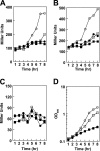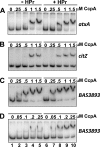Glucose-dependent activation of Bacillus anthracis toxin gene expression and virulence requires the carbon catabolite protein CcpA
- PMID: 20971911
- PMCID: PMC3019961
- DOI: 10.1128/JB.01656-09
Glucose-dependent activation of Bacillus anthracis toxin gene expression and virulence requires the carbon catabolite protein CcpA
Abstract
Sensing environmental conditions is an essential aspect of bacterial physiology and virulence. In Bacillus anthracis, the causative agent of anthrax, transcription of the two major virulence factors, toxin and capsule, is triggered by bicarbonate, a major compound in the mammalian body. Here it is shown that glucose is an additional signaling molecule recognized by B. anthracis for toxin synthesis. The presence of glucose increased the expression of the protective antigen toxin component-encoding gene (pagA) by stimulating induction of transcription of the AtxA virulence transcription factor. Induction of atxA transcription by glucose required the carbon catabolite protein CcpA via an indirect mechanism. CcpA did not bind specifically to any region of the extended atxA promoter. The virulence of a B. anthracis strain from which the ccpA gene was deleted was significantly attenuated in a mouse model of infection. The data demonstrated that glucose is an important host environment-derived signaling molecule and that CcpA is a molecular link between environmental sensing and B. anthracis pathogenesis.
Figures










Similar articles
-
Bacillus anthracis Virulence Regulator AtxA Binds Specifically to the pagA Promoter Region.J Bacteriol. 2019 Nov 5;201(23):e00569-19. doi: 10.1128/JB.00569-19. Print 2019 Dec 1. J Bacteriol. 2019. PMID: 31570528 Free PMC article.
-
In vivo Bacillus anthracis gene expression requires PagR as an intermediate effector of the AtxA signalling cascade.Int J Med Microbiol. 2004 Apr;293(7-8):619-24. doi: 10.1078/1438-4221-00306. Int J Med Microbiol. 2004. PMID: 15149039 Review.
-
Full expression of Bacillus anthracis toxin gene in the presence of bicarbonate requires a 2.7-kb-long atxA mRNA that contains a terminator structure.Res Microbiol. 2010 May;161(4):249-59. doi: 10.1016/j.resmic.2010.03.003. Epub 2010 Mar 30. Res Microbiol. 2010. PMID: 20359529
-
Structural and Functional Analysis of Toxin and Small RNA Gene Promoter Regions in Bacillus anthracis.J Bacteriol. 2022 Sep 20;204(9):e0020022. doi: 10.1128/jb.00200-22. Epub 2022 Aug 31. J Bacteriol. 2022. PMID: 36043862 Free PMC article.
-
AtxA, a Bacillus anthracis global virulence regulator.Res Microbiol. 2010 Nov;161(9):735-42. doi: 10.1016/j.resmic.2010.09.006. Epub 2010 Sep 21. Res Microbiol. 2010. PMID: 20863885 Review.
Cited by
-
Global transcriptional control by glucose and carbon regulator CcpA in Clostridium difficile.Nucleic Acids Res. 2012 Nov;40(21):10701-18. doi: 10.1093/nar/gks864. Epub 2012 Sep 18. Nucleic Acids Res. 2012. PMID: 22989714 Free PMC article.
-
Glucose 6P binds and activates HlyIIR to repress Bacillus cereus haemolysin hlyII gene expression.PLoS One. 2013;8(2):e55085. doi: 10.1371/journal.pone.0055085. Epub 2013 Feb 6. PLoS One. 2013. PMID: 23405113 Free PMC article.
-
The Role of Regulator Catabolite Control Protein A (CcpA) in Streptococcus agalactiae Physiology and Stress Response.Microbiol Spectr. 2022 Dec 21;10(6):e0208022. doi: 10.1128/spectrum.02080-22. Epub 2022 Oct 20. Microbiol Spectr. 2022. PMID: 36264242 Free PMC article.
-
BrnQ-Type Branched-Chain Amino Acid Transporters Influence Bacillus anthracis Growth and Virulence.mBio. 2022 Feb 22;13(1):e0364021. doi: 10.1128/mbio.03640-21. Epub 2022 Jan 25. mBio. 2022. PMID: 35073743 Free PMC article.
-
Giving a signal: how protein phosphorylation helps Bacillus navigate through different life stages.FEMS Microbiol Rev. 2023 Jul 5;47(4):fuad044. doi: 10.1093/femsre/fuad044. FEMS Microbiol Rev. 2023. PMID: 37533212 Free PMC article. Review.
References
-
- Arantes, O., and D. Lereclus. 1991. Construction of cloning vectors for Bacillus thuringiensis. Gene 108:115-119. - PubMed
Publication types
MeSH terms
Substances
Grants and funding
LinkOut - more resources
Full Text Sources
Miscellaneous

